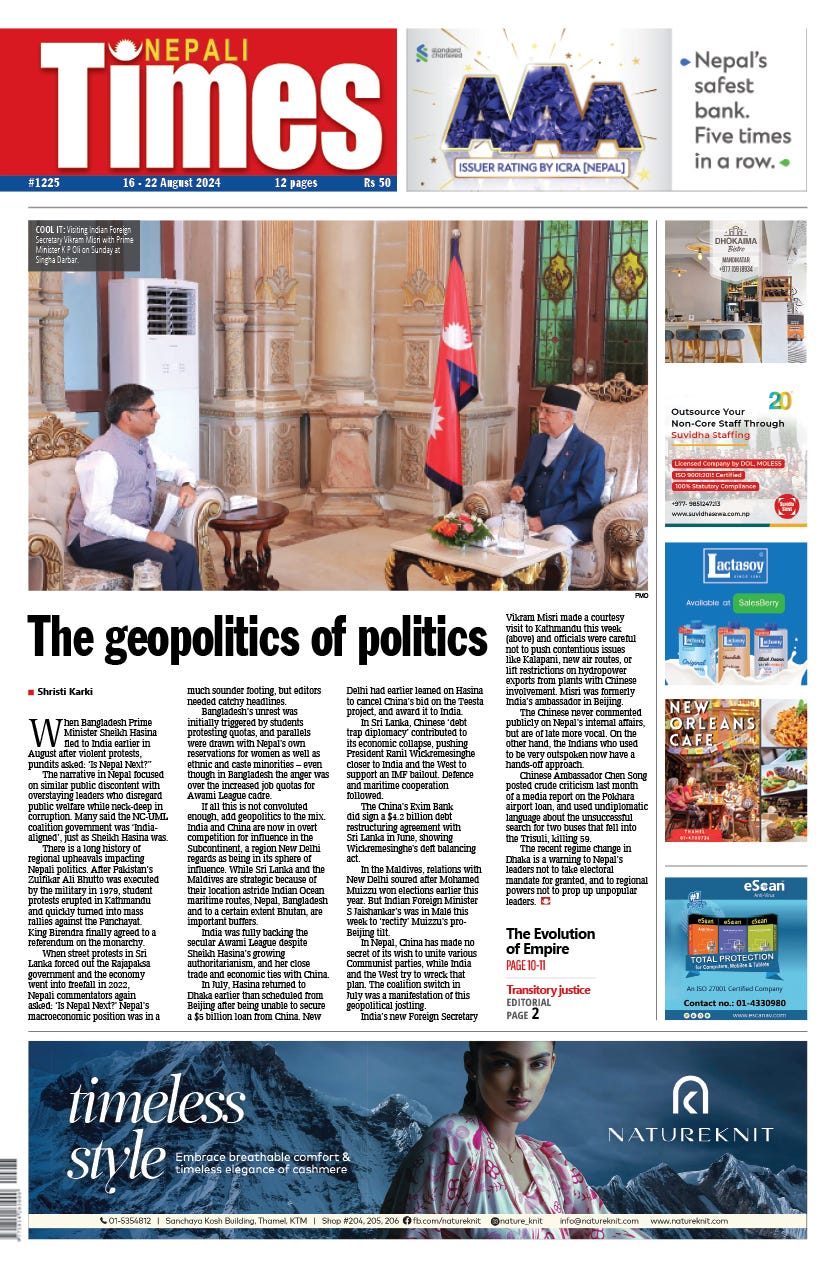Greetings from Mudmandu,
We are now in the third week of August, and it seems the monsoon is asserting itself with renewed vigour. We already had double the monthly average of precipitation for August in the first two weeks of the month.
There is plastic and garbage trapped on metal fences above the Bagmati indicating the high water mark in recent floods. Sinkholes have appeared in the middle of Kathmandu’s streets. Trucks are stranded tyre-deep in mud on the Pokhara highway. And half of Thame village was washed away last week when two glacial lakes over spilled, fortunately with no casualties.
The monsoon gets bad press, but it is the best time to be in Nepal. The air is clean, the countryside is emerald green, when the mountains do peek through the clouds they look close enough to touch.
The Ministry of Marxism, Leninism and Tourism should do more to promote Nepal’s rain — especially in desert $heikhdoms where it has not rained since the OPEC Oil Crisis. We give them migrant workers, they give us tourists.
We need new slogans to promote monsoon tourism, and here are a few suggestions:
‘Off to Nepal in the Off Season’
‘Visit Nepal Where It Always Rains in Your Parade’
‘Ooze with Fun in Muckraker’s Paradise’
‘Come To the Glastonbury of the Himalaya’
‘Enroll in 3-week Course in Political Mudslinging’
‘Nepal Airlines Flies You to the Slime with a Smile’
‘Visit Nepal, and Take a Rain-Cheque’
The Nepali Times centrefold this week shows how Pokhara has found a way to promote monsoon tourism by turning itself into a yoga and meditation hub. Our reporter Durga Rana Magar in her piece ‘From Medication to Meditation in the Mountains’ (page 6-7) interviews yoga entrepreneurs who combine treks with meditation.
On page 1, Special Correspondent Shristi Karki peels away the layers of recent Nepali politics to see how it is impacted by India-China rivalry. ‘Geopolitics of Politics’ looks at recent events in Sri Lanka, Maldives, and more recently Bangladesh to see where Nepal fits in.
The Editorial this week provides everything you need to know about the Enforced Disappearances Inquiry, Truth and Reconciliation Commission Act of 2014 which was finally passed by Parliament this week. Santa Gaha Magar, the editor of our sister publication Himal Khabar, says that it may be too early to be euphoric about the cross-party consensus on Nepal’s transitional justice process. All is not well until it ends well.
Ward Chair and founder of the Tharu Culture Museum reminds us on page 5 about the indigenous knowledge and practices of his community to Chitwan’s ecosystem and biodiversity. Nepal’s conservation will only succeed if we say ‘Parks Plus People’ and not ‘Parks vs People’.
Happy Gai Jatra, which this year falls on 20 August.
PS: Make some time to read Sonia Awale’s article from after the 2015 earthquake about how Gai Jatra has its roots in the Newa festival of Saparu which remembers the dead.
Until next time,
Kunda Dixit






I'm genuinely passionate about research and writing, and I am eager to contribute my articles and research work for publication. I would welcome the opportunity to collaborate with Nepali Times and share my insights through your esteemed platform.